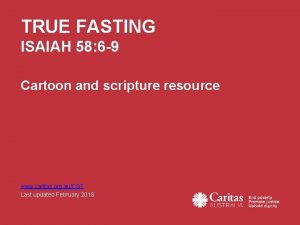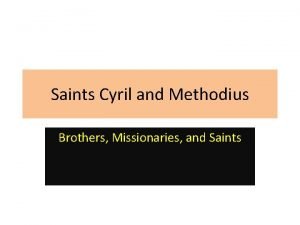Saints You have not chosen me I have







- Slides: 7

Saints

You have not chosen me; I have chosen you. Go and bear fruit that will last. John 15: 16 • Apostle-one sent forth on a mission • Disciples-a follower of Christ who carries on Christ’s mission by showing others the love of God. • Tradition-the body of official church teachings, rituals, customs, and practices that have developed under the guidance of the holy Spirit and are handed down from the apostles. • Evangelize-to tell others the good news of Jesus Christ. • Evangelists-people called to go forth and evangelize the world.

To become a Saint • The process by which someone becomes a saint is called canonization. • The Catholic church has canonized around 3, 000 people -- the exact number is unknown because not all saints were officially canonized. • According to the church, the pope does not make someone a saint -- the designation of sainthood only recognizes what God has already done. • For centuries, saints were chosen through public opinion. In the 10 th century, Pope John XV developed an official canonization process.

• The process of becoming a Catholic saint is lengthy, often taking decades or centuries to complete. • The canonization process has been in the news off and on over the past few years, primarily because of the movement to make Mother Teresa and Pope John Paul II saints.

The Steps of Canonization Here are the steps that must be followed in the process of canonization: • 1. A local bishop investigates the candidate's life and writings for evidence of heroic virtue. The information uncovered by the bishop is sent to the Vatican. • 2. A panel of theologians and the cardinals of the Congregation for Cause of Saints evaluate the candidate's life. • 3. If the panel approves, the pope proclaims that the candidate is venerable, which means that the person is a role model of Catholic virtues. • 4. The next step toward sainthood is beatification, which allows a person to be honored by a particular group or region. In order to beatify a candidate, it must be shown that the person is responsible for a posthumous miracle. Martyrs -- those who died for their religious cause -can be beatified without evidence of a miracle. On Oct. 20, 2003, Mother Teresa was beatified. She is now known as Blessed Mother Teresa of Kolkata. • 5. In order for the candidate to be considered a saint, there must be proof of a second posthumous miracle. If there is, the person is canonized.

In Mother Teresa's case, her supporters are arguing that she has performed at least two posthumous miracles. In one case, a French woman in the United States broke several ribs in a car accident -- reportedly, her wounds were healed because she was wearing a Mother Teresa medallion. Another possible miracle occurred when Mother Teresa appeared in the dreams of a Palestinian girl, telling the girl that her cancer was cured.

Your Saint Project 1. You may select any saint that you have not researched before. 2. You may select any saint that was born after 1850. 3. Tomorrow, you must have a saint to research that no one else in your class is working on. 4. Read over the directions given to you. 5. This project is due on Monday, November 10 th.













